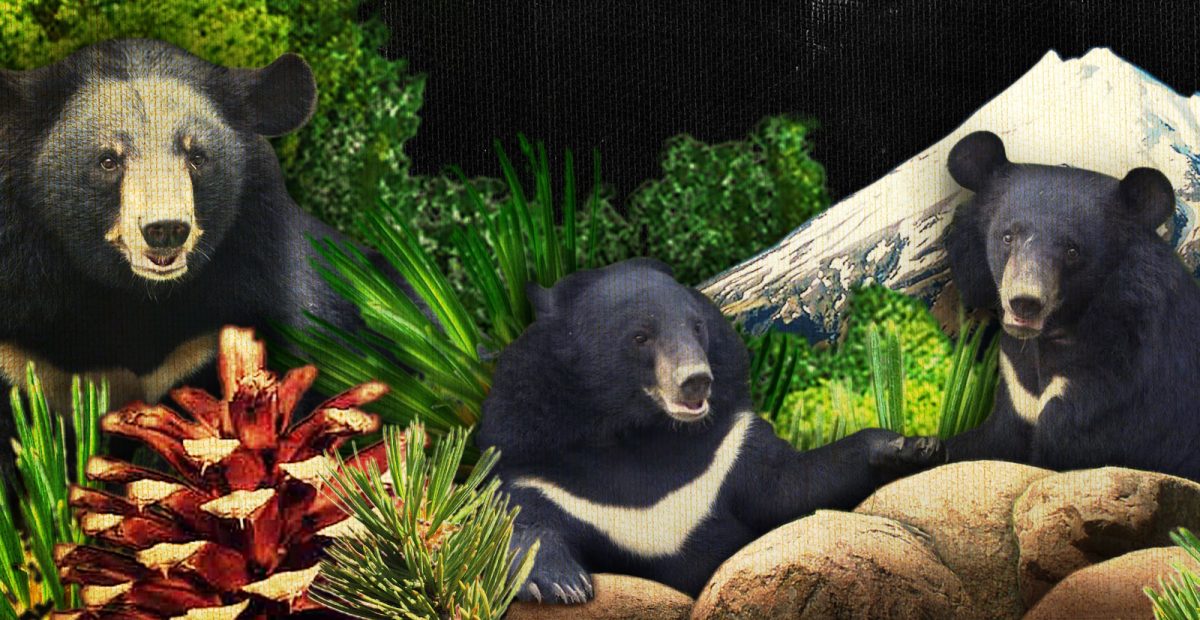
Current Situation
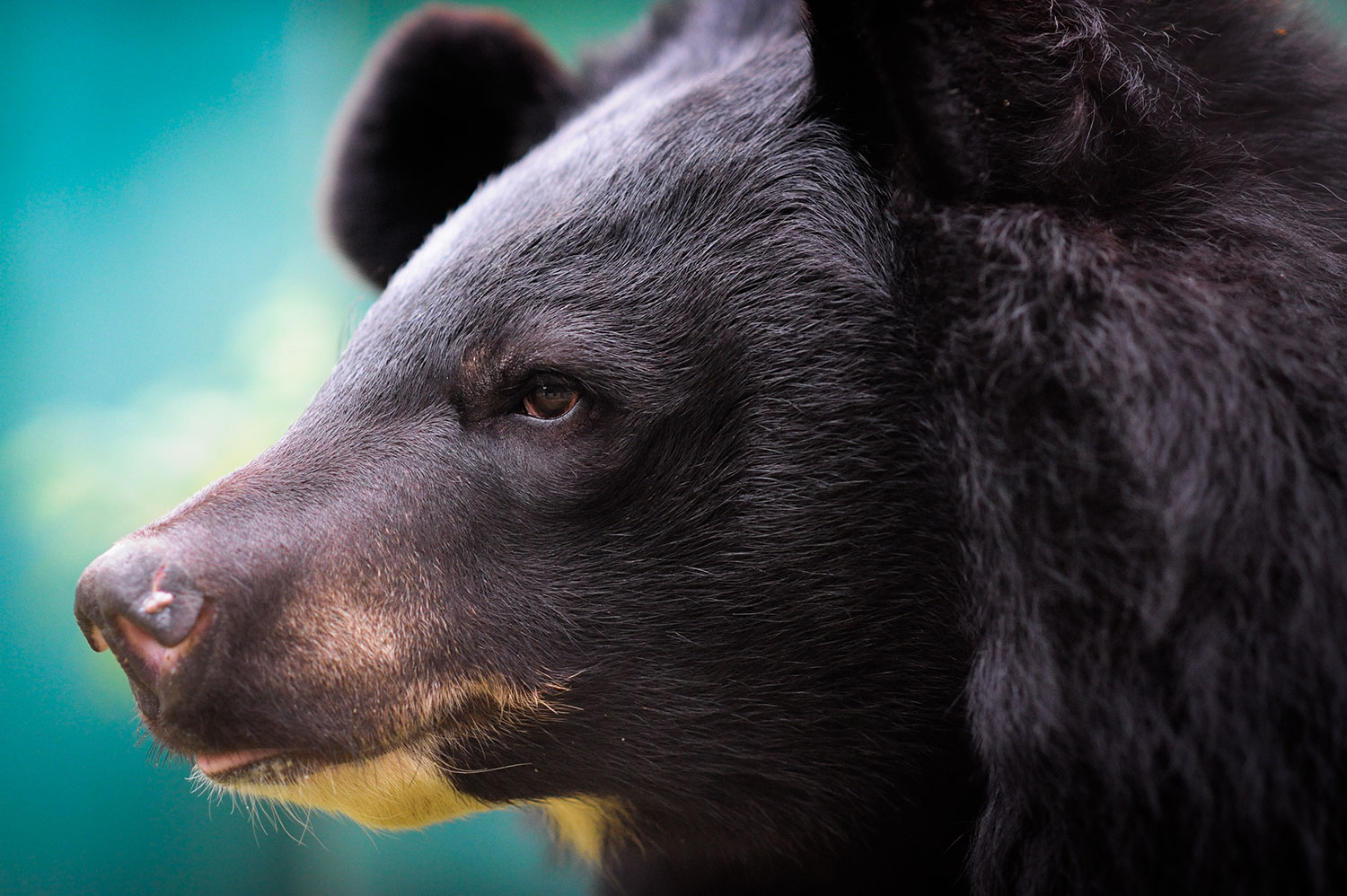
No animal symbolizes the wilderness and forest quite like the majestic bear. In North America as well as Asia, bears conjure visions of freedom and serenity, power and gentleness surrounded by the beauty of undisturbed nature.
Nicknamed the “moon bear” for the white crescent moon shape on its chest, the Asiatic black bear for millions of years roamed the vast forests of Asia unimpeded by humankind. These powerful creatures lived in harmony with their natural surroundings until around 3,000 years ago, when humans living in what is now China began killing them, removing their gallbladders and extracting the bile to treat various human medical ailments such as fever, gallstones, and eye irritation.
As a way to prevent total extinction of the species, scientists developed a procedure to extract bile from the gallbladders of fully conscious living bears whom they kept imprisoned in cages
This barbaric custom spread throughout all of Asia and continues to this day. In the mid-20th century, the practice took an even more horrific turn. Because so many moon bears had been killed for their gallbladders, the species began to go extinct in many regions of Asia. As a way to prevent total extinction of the species, scientists developed a procedure to extract bile from the gallbladders of fully conscious living bears, which they kept imprisoned in cages.
Hundreds of Bear Bile Farms Throughout Asia

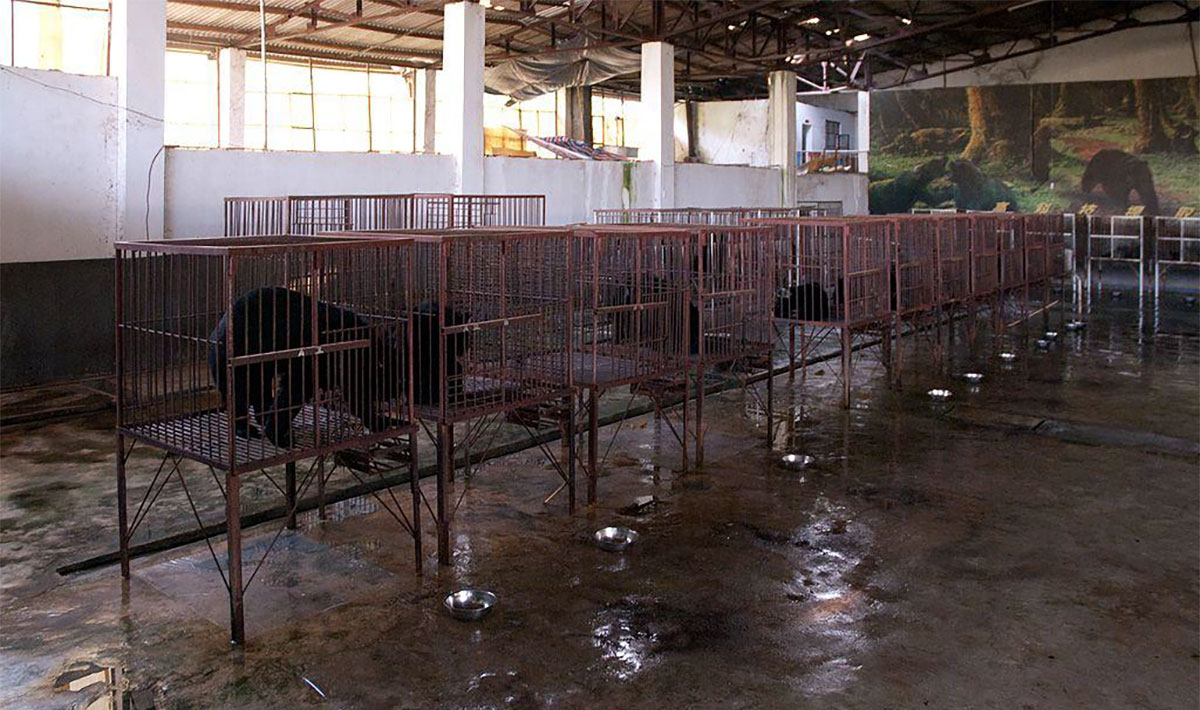
Today, throughout Asia, thousands of Asiatic black bears are kept in “crush” cages on bear bile farms, where they spend their lives barely able to move. Many cages are so small the bears are unable to turn around or stand on their back feet. Sometimes the cages are so restrictive the bears can’t even stand on all fours. Some bears are put into cages as cubs and never released. In China alone more than 10,000 bears live in misery on these farms. In Vietnam, according to the latest government figures, approximately 1,000 bears suffer the same fate, and many more languish in other southeast Asian countries. Bile farms are rarely regulated by any governmental bodies, and very few inspections ever take place, resulting in filthy, disease-ridden conditions. For the bears living on these farms, life is a living hell. These intelligent creatures, who would normally roam peaceful and free in the wild, live instead in minuscule cages and have their bile painfully extracted on a daily basis. Bears may be kept caged for up to 30 years, but most die after five years, suffering from multiple diseases, starvation, dehydration and severe depression. The bears’ muscles atrophy from lack of exercise, and their teeth and claws are often removed to prevent injuries to the farmers. It is not uncommon for bears to attempt suicide by starving themselves to death to escape the suffering they experience on the bile farms.
Bears may be kept caged for up to 30 years but most die after 5 years, suffering from multiple diseases, starvation, dehydration and severe depression
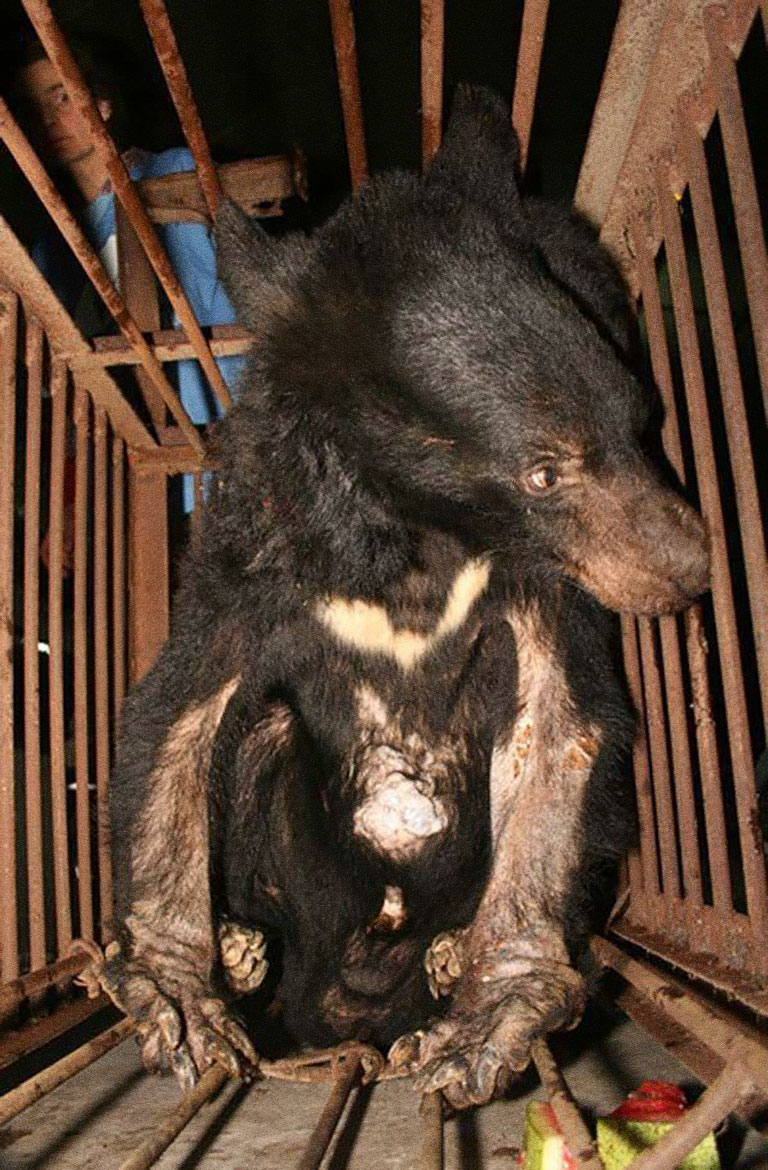
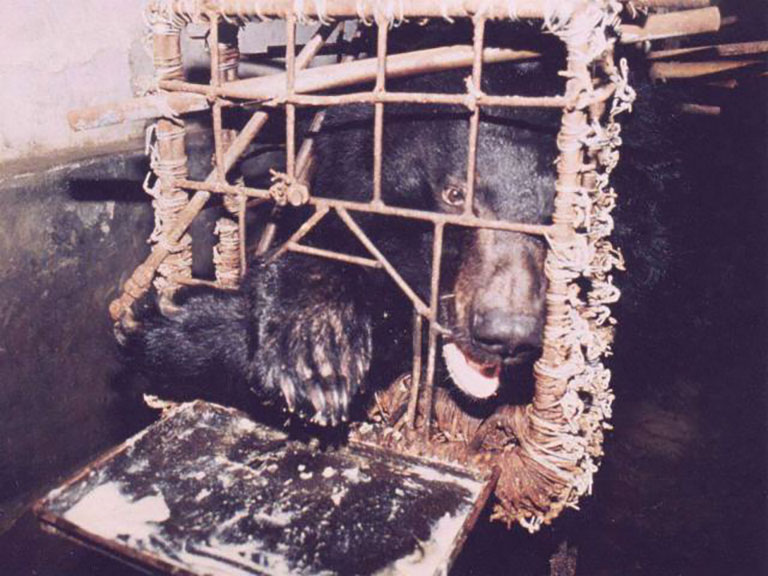
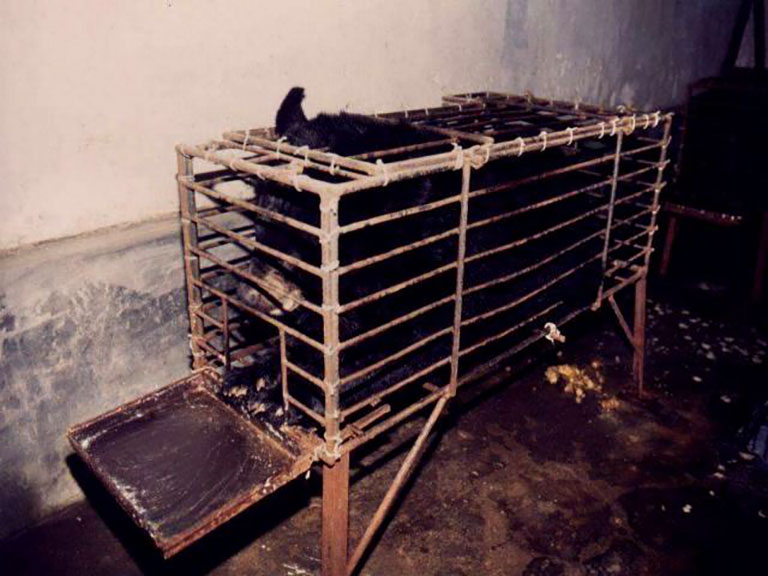
The Extraction Process

Extraction of a bear’s bile is done in a process the farmers call “milking,” and is usually performed twice a day. A catheter in the form of a rubber or steel tube is implanted into the bear’s abdomen by the farmer. The bile is then drained from the catheter, collected, and sold to traditional Asian medicine manufacturers. Because the farmers have no veterinary training and are not at all qualified to perform surgery on animals, almost half of all bears on bile farms die from infections and other complications of the surgery.
In the late 1990s, the Chinese government banned the use of the catheter method of bile collection, favoring instead the “free drip” method. “Free drip” involves a surgery to create an open hole in the bear’s abdomen through which bile freely drips out. The Chinese government claimed this method was more humane, yet it has proven to be just as cruel as the catheter method. Bile often leaks back into the bear’s abdomen, increasing the rate of infection. Moreover, the bear’s body naturally tries to heal itself and regrow skin over the hole, resulting in even more painful surgeries. Most farmers have been financially unable to implement the “free drip” method, so the catheter method still predominates, though illegal.
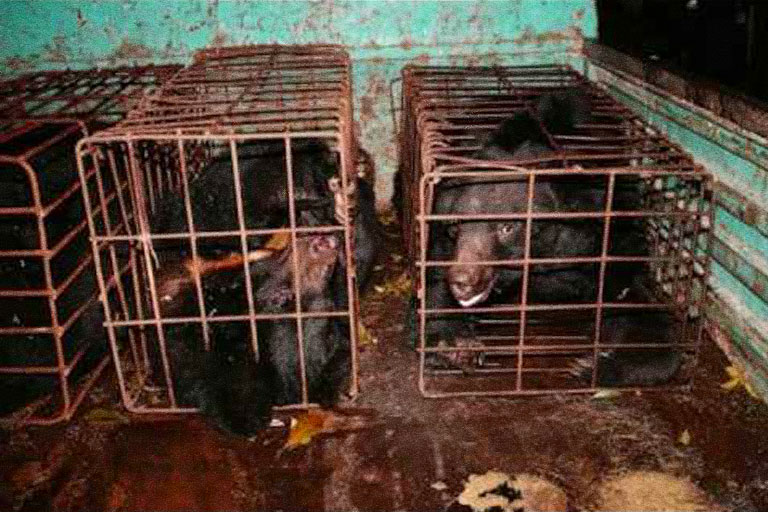
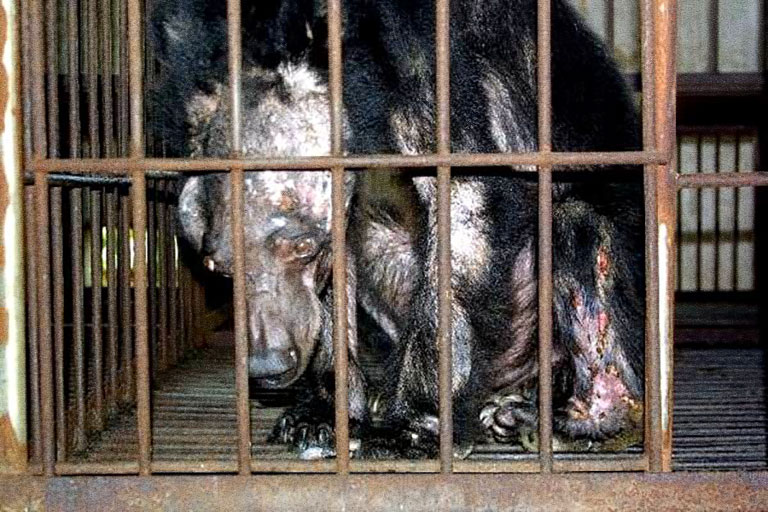
Bear Bile Trade Finally Exposed

The horrors of bear bile farms finally began to be exposed in the 1990s, thanks to the committed effort of animal rights groups like Animals Asia and Free the Bears. Through the tireless work of these and other animal rights organizations, millions of people throughout the world are being educated about the bear bile industry and are demanding an end to this blatant exploitation.
These organizations have also uncovered a North American connection to the Asian bear bile trade. American black bears are being targeted as a result of the demand for bear bile from both Asia and the Asian population in the United States and Canada. It has been estimated that as many as 40,000 American black bears are illegally killed in North America each year, poached for their gallbladders and paws in the Chinese traditional medicine market. Conservationists estimate that for every bear killed legally in North America, two are killed illegally. These bears are hunted down in regions all over the continent, from the Smoky Mountains in the southeastern United States to the forests of Maine and the Canadian Rockies. Vancouver, British Columbia has become a major center of the illegal bear trade. One raid by Canadian conservation officers uncovered 191 bear gall bladders, and another found 84 bear paws in a basement freezer.
Recently, high profile celebrities like Guns ‘N Roses drummer Matt Sorum, comedian Ricky Gervais, and British actress Lesley Nicol of Downton Abbey have brought the plight of China’s farmed bile bears to the attention of the entertainment media. All three have spoken publicly about the need to end this cruel practice, and have adopted rescued bears now living in bear sanctuaries. Together with Jill Robinson of Animals Asia, they are educating people that the bear bile industry is horrific and completely unnecessary. Inexpensive synthetic and herbal alternatives to bear bile are readily available in the marketplace; they are just as effective and cruelty-free.
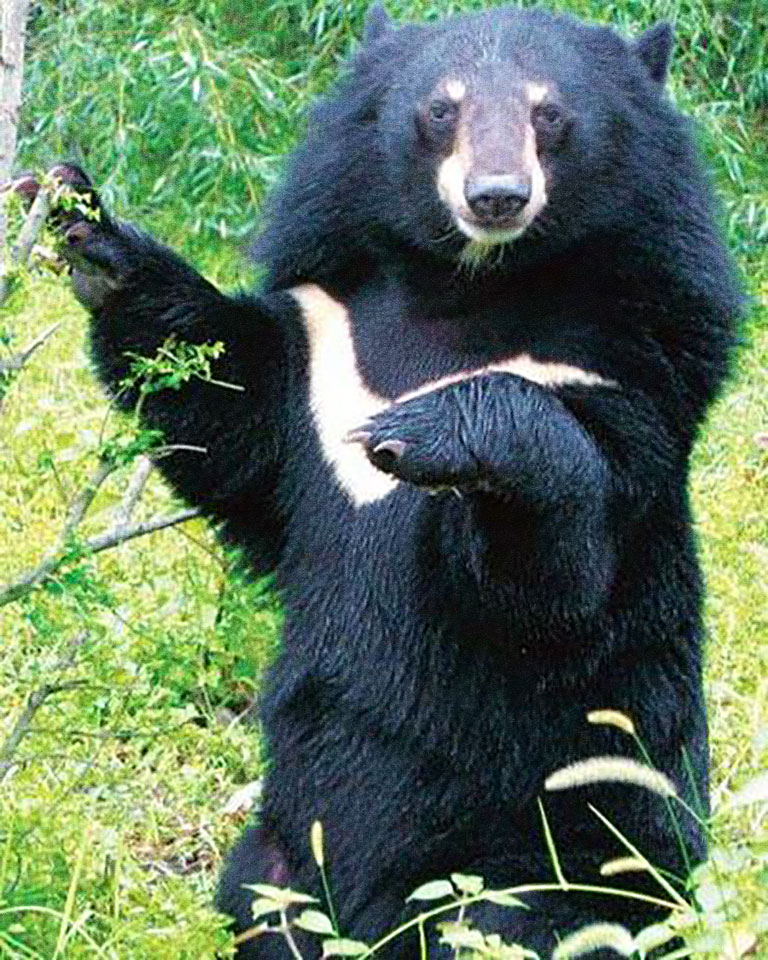
American black bears are being targeted as a result of the demand for bear bile
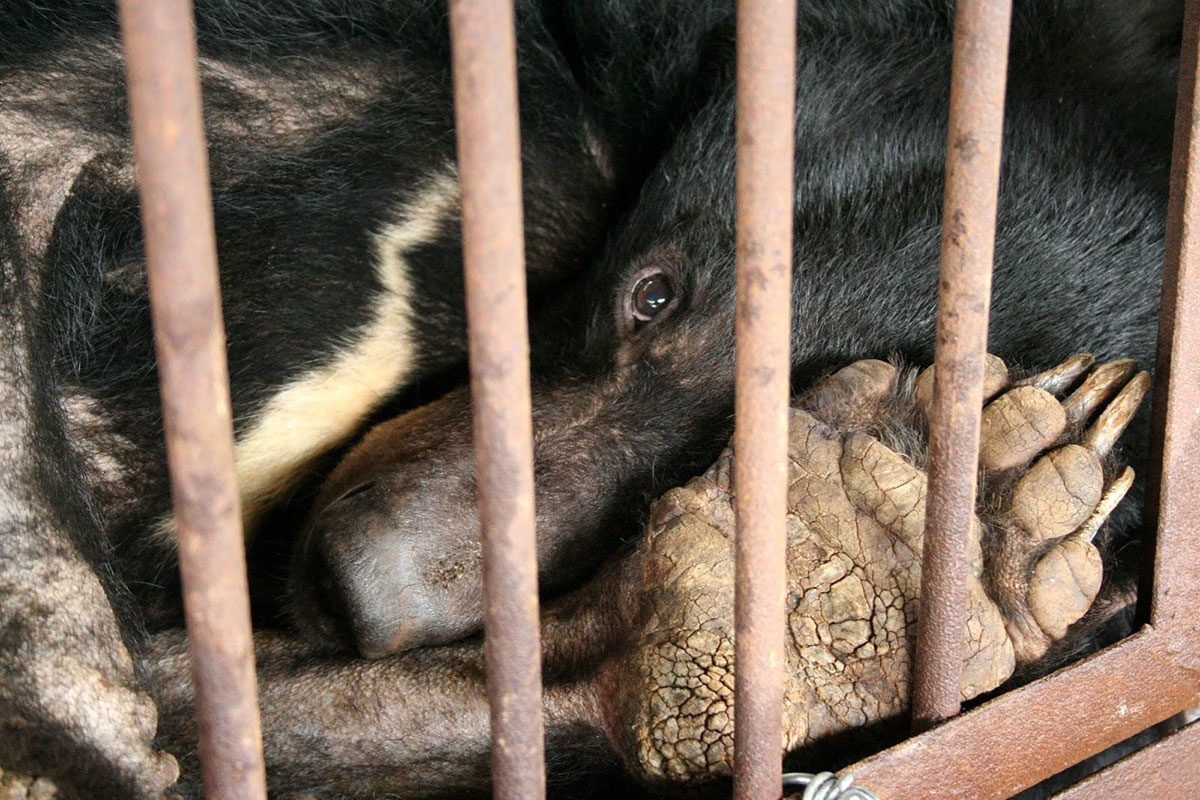

Positive Change
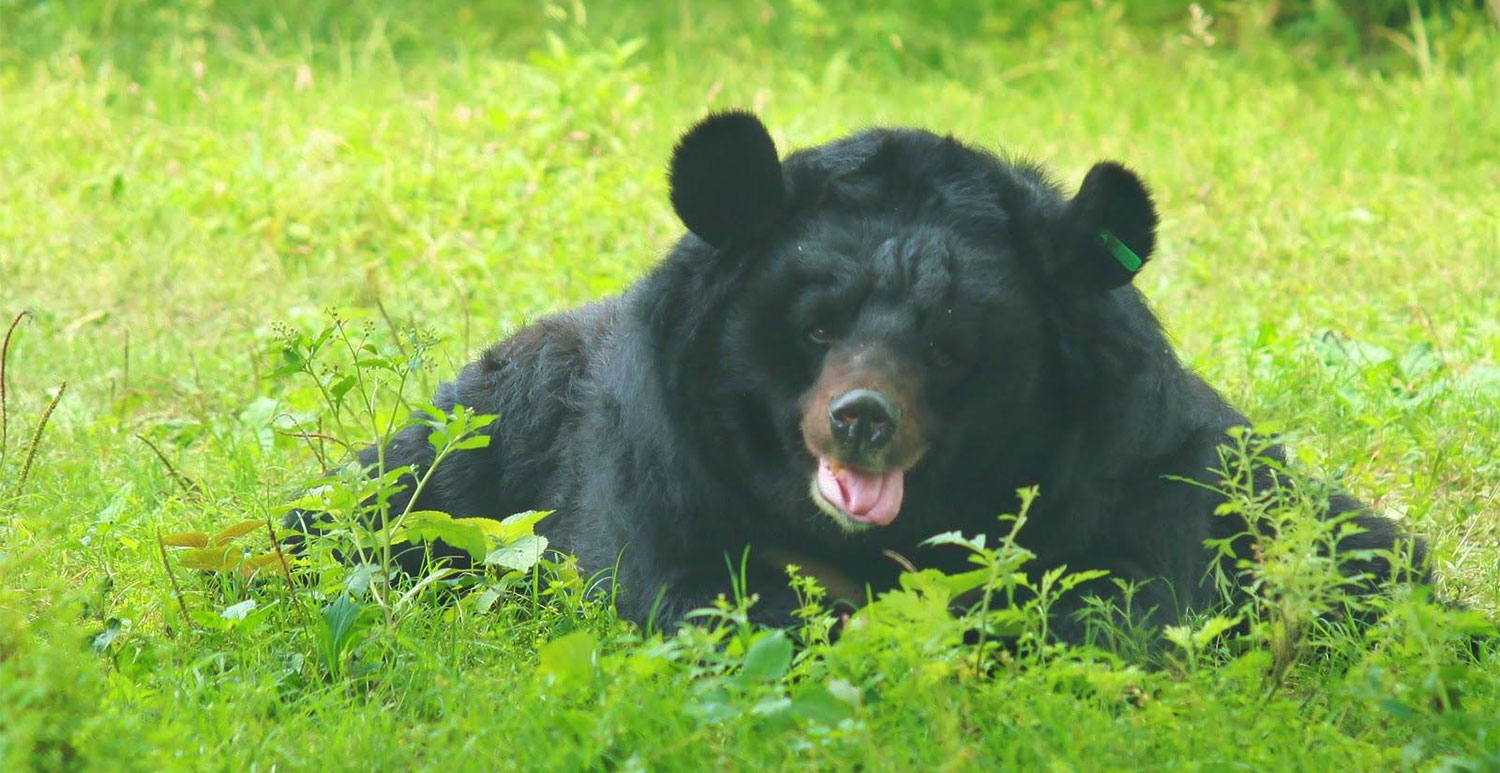
North Korean scientists first developed the inhumane procedure of extracting bile from the gallbladders of fully conscious bears in the 1940s. In the 1980s, however, the number of Asiatic moon bears in the wild dropped dramatically due to poaching and over-hunting, and bear bile farms began appearing throughout North and South Korea, Vietnam, China and other southeast Asian countries. The farms existed in near anonymity with little scrutiny until the late 1990s when, thanks to the tireless efforts of Jill Robinson, her organization Animals Asia, and Australian based Free the Bears, the cruel practices and horrific conditions of the farms finally came into the public light. Since then, public condemnation of the farms in both Asia and the western world has continued to grow, with dramatic increase seen over the last ten years.
In Asia, this public outcry has coincided with an unprecedented surge in animal rights activism throughout the continent. For large segments of China’s younger population, saving the moon bear has become an issue of national pride and importance. Numerous national celebrities have also lent their support to the campaign to end bear bile farming. The cause received a massive boost in 2012 when one of the most famous Chinese athletes of all time, former NBA star Yao Ming, visited an Animals Asia Bile Bear Sanctuary in the Sichuan Province of China and publicly denounced exploiting bears for their bile.
In the Western world, numerous celebrities have spoken out against bear bile farms and have publicly supported the campaign, including Vampire Diaries star Ian Somerhalder, Twilight stars Nikki Reed and Kellan Lutz, Kristin Bauer van Straten, Lesley Nicol, and Alicia Silverstone. Musicians Matt Sorum and Peter Northcote, entrepreneur Russell Simmons, chef Simon Bryant and comedians Meshel Laurie, Ricky Gervais, and Ben Elton have also voiced their support for Animals Asia’s campaign to End Bear Bile Farming.
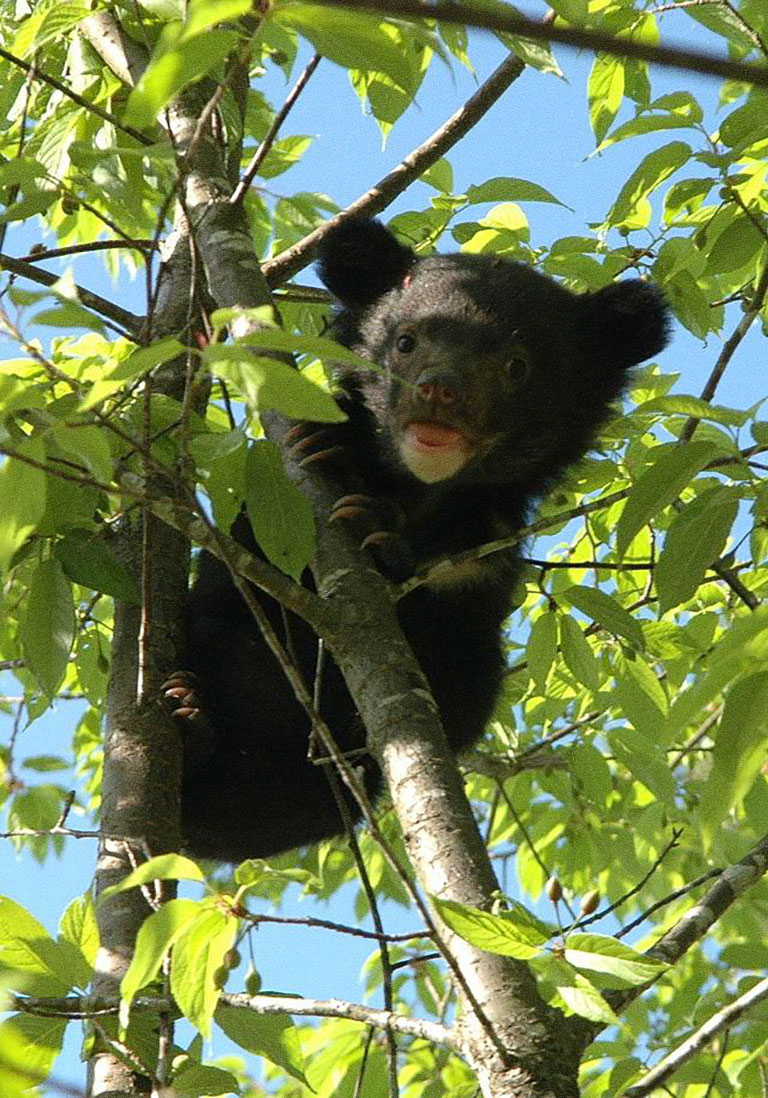
For large segments of China’s younger population, saving the moon bear has become an issue of national pride and importance
Animals Asia

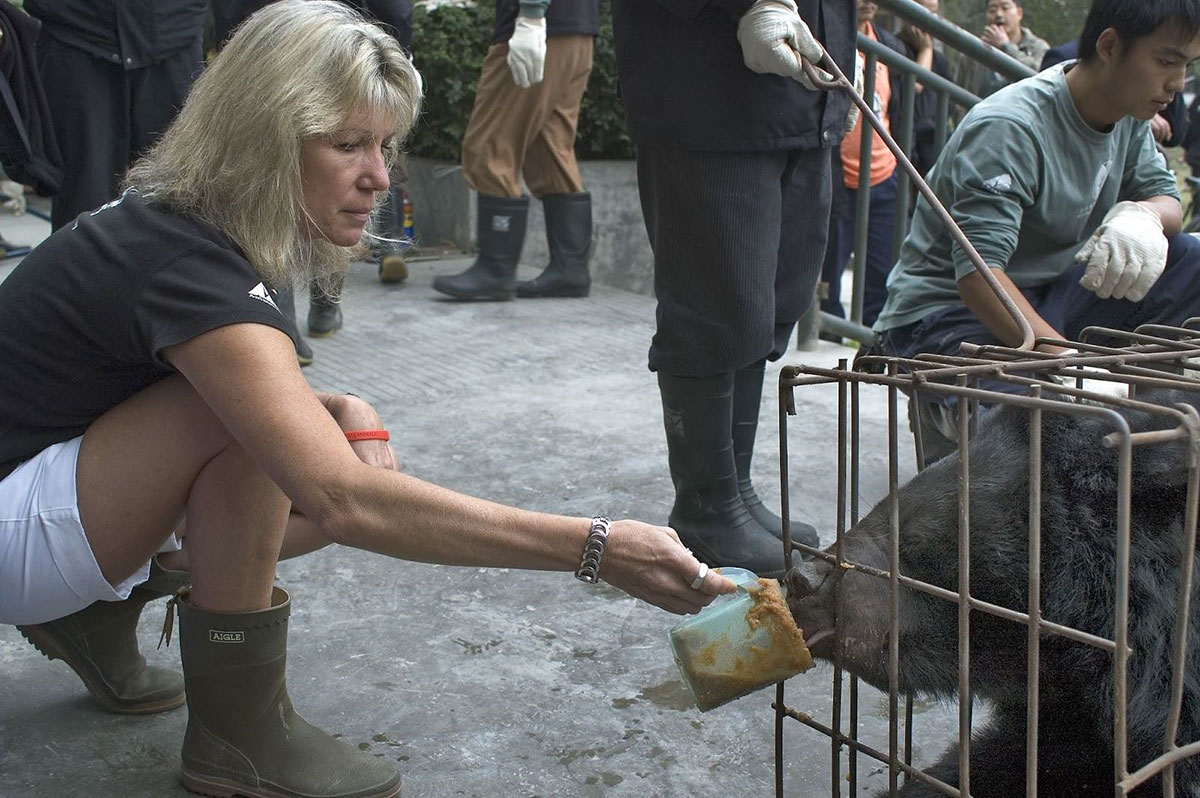
Founded in 1998 by Jill Robinson, Animals Asia has been a major force in exposing the cruel bear bile trade to the outside world and transforming Asian public opinion on the issue. Robinson first learned of the horrors of bear bile farming when she saw firsthand the horrific conditions the bears endured on a Chinese farm in 1994. Seeing the unspeakable suffering of the bears in the tiny crush cages left her devastated and she immediately began devising means of rescue. For the next four years she actively helped rescue many bears and in 1998 founded Animals Asia.
Today, in addition to operating three bile bear sanctuaries that are home to more than 400 rescued bears, Animals Asia actively conducts public awareness campaigns throughout Asia, particularly in China and Vietnam, highlighting the cruelty of the bear bile industry and building support for an end to the industry. Animals Asia runs billboard advertising campaigns and presentations in community centers, schools and traditional medicine universities to get the message out to the public. They also collaborate with dozens of other animal welfare groups and numerous Chinese university student groups to spread the message through street displays, photo exhibitions, plays, poster art and social media.
The Animal Asia bile bear sanctuaries provide the rescued bears secure, natural, wooded rehabilitation areas with bamboo enclosures; the bears have a stimulating and safe environment for the remaining years of their lives. Two of the sanctuaries are located in China, one in Chengdu and another in Nanning (soon to be opened). The third sanctuary is located in Vietnam. The Nanning sanctuary was formerly a bear bile farm that Animals Asia took over in April 2014. These three sanctuaries employ over 250 local employees, with hundreds more employed indirectly through services and construction.

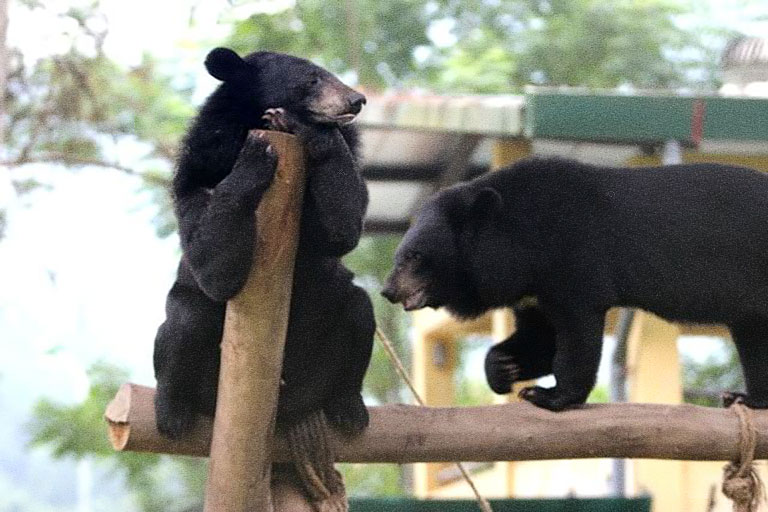
The vast majority of the bears now living at the Animal Asia sanctuaries needed significant rehabilitation and medical attention when they arrived, having endured years of physical and psychological neglect and abuse on bear bile farms. During their rehabilitation, all facets of the bears’ emotional and physical health are closely monitored by sanctuary workers through routine health checks and daily observation. Important scientific data on the physical and psychological effects of bile extraction has been published by the sanctuaries’ medical staffs and has helped raise the profile of the Asiatic black bear within the Asian scientific community.
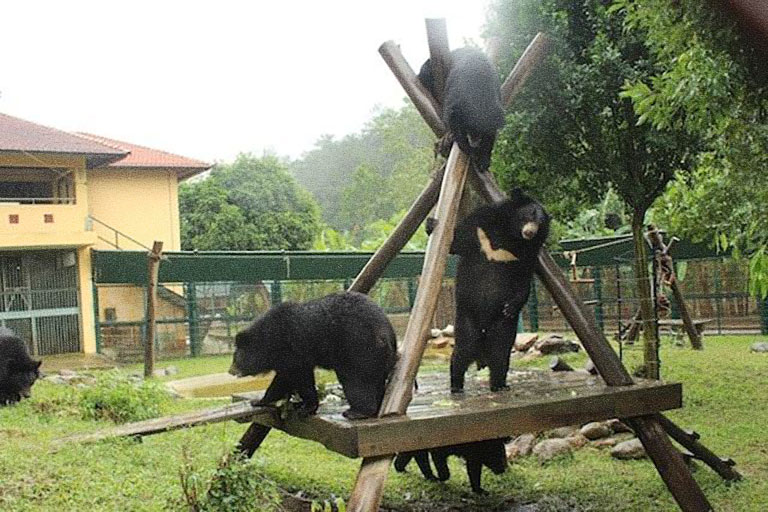

Specialist veterinary ophthalmologists from the UK’s Animal Health Trust, after learning that some of the bears arrive at the sanctuaries blind, have traveled to the Animal Asia sanctuaries multiple times to help with various eye problems and have restored sight to several previously blind bears using a surgical technique known as phacoemulsification. These surgeries were the first ever cataract surgeries performed on moon bears and received worldwide attention.
All three sanctuaries, particularly the soon to be converted bear bile farm in Nanning, receive widespread Asian and global media coverage. Each sanctuary is also an educational center, with public education classrooms containing displays and actual cages and equipment from bile farms. The sanctuaries work closely with schools and educational institutions – hosting summer camps for university students from throughout China and welcoming a constant stream of primary students from the surrounding areas.
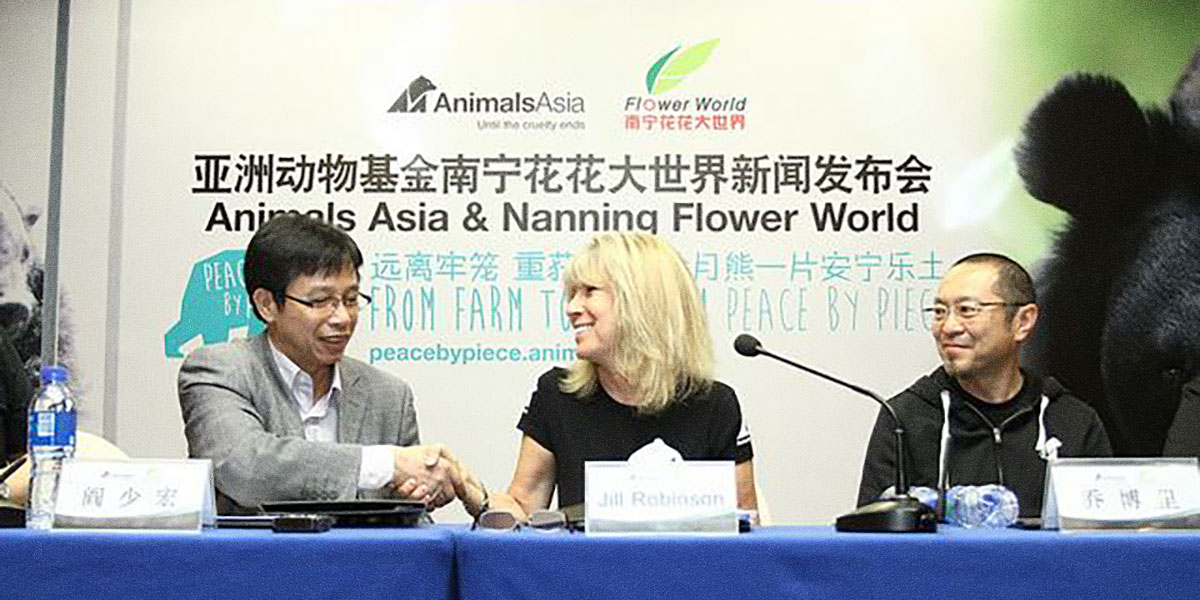
Free The Bears

Australian Mary Hutton formed Free the Bears in 1995 after watching a television documentary on the plight of Asiatic bears in the bear bile industry. Free the Bears is very active at the grassroots level, organizing raffles, film nights and other events in villages throughout Cambodia, Laos, Vietnam and Thailand, raising awareness of the bear bile industry in the local communities.
In addition to ending bile bear farming, Free the Bears is very dedicated to ending the exploitation of all bears used in the cruel ‘dancing bear’ entertainment trade throughout Asia, particularly India. Working with Maneka Gandhi, Wildlife SOS, and International Animal Rescue for the last fourteen years, Free the Bears has administered the Kalander Rehabilitation Program, providing over one million dollars in seed money for more than five hundred poor Kalander families who once exploited bears to eke out a meager living. The ongoing program has set up a variety of new, sustainable livelihoods for each family, including sari-weaving, bicycle repair, auto-rickshawing, and selling spices. Extensive training has been given to each family, with particular attention paid to ensure that Kalandar women are given the opportunity to also take part in the scheme, and children are given scholarships to gain a higher education.
With the help of other animal welfare organisations, Free The Bears has facilitated the establishment of bear sanctuaries in Vietnam, Laos, Thailand, Indonesia, Cambodia, India and the world’s largest sun bear sanctuary in Cambodia
The Kalandar Rehabilitation Program has been a massive success. Some Kalandar families are even employed in the sanctuaries that have been set up to give a nurturing, permanent home to the more than five hundred rescued bears. These families work alongside the bears they once exploited, witnessing the transformation as the bears revert to their natural behaviors after years of suffering.
With the help of other animal welfare organizations, Free the Bears has facilitated the establishment of bear sanctuaries in Vietnam, Laos, Thailand, Indonesia, Cambodia, India and the world’s largest sun bear sanctuary in Cambodia.
Synthetic Bile Alternatives

Modern science and traditional herbal medicine have developed two alternatives to bear bile, both of which have proven to be more effective. The modern alternative uses a synthetic form of ursodeoxycholic acid (UDCA) developed in the laboratory. UDCA is the active ingredient in bear bile and is now widely available. The University of Minnesota Medical School has shown that it is possible to produce UDCA in the laboratory without using any animal tissue, and at only a fraction of the cost of farmed bear bile.
In July of 2014, China’s largest bear bile pharmaceutical company, KaiBao Pharmaceutical, announced it was pursuing research on synthetic alternatives with additional funding from the Chinese government. KaiBao is a cornerstone of the Chinese bear bile industry. It supplies about half of all bear bile purchased for traditional medicine in China each year–in 2012 alone, it bought 18 tons of bear bile powder. Then, in August of 2015, Kaibao announced that the research had successfully resulted in a fully synthesised substitute for bear bile. The significance of this development cannot be overstated. The fact that it was heavily backed and funded by the Chinese government shows a clear intent at the highest levels to move away from bear bile farming.
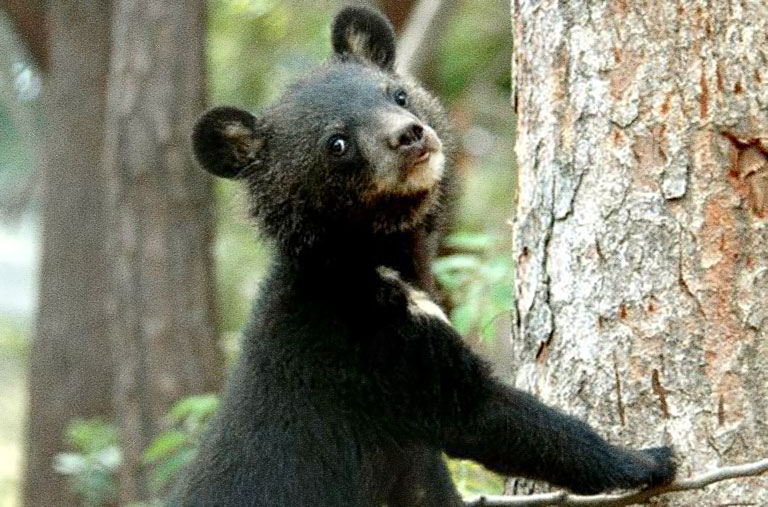
In July of 2014, China’s largest bear bile pharmaceutical company, KaiBao Pharmaceutical, announced it was pursuing research on synthetic alternatives with additional funding from the Chinese government. KaiBao is a cornerstone of the Chinese bear bile industry. It supplies about half of all bear bile purchased for traditional medicine in China each year–in 2012 alone, it bought 18 tons of bear bile powder. Then, in August of 2015, Kaibao announced that the research had successfully resulted in a fully synthesised substitute for bear bile. The significance of this development cannot be overstated. The fact that it was heavily backed and funded by the Chinese government shows a clear intent at the highest levels to move away from bear bile farming.
Modern science and traditional herbal medicine have developed two alternatives to bear bile, both of which have proven to be more effective
The second substitute for bear bile involves the use of herbal extracts. This method has been used by many practitioners in Asia for centuries, but the erroneous myth that bear bile is more effective has persisted until very recently. Since 2008, Professor Feng Yibin at the University of Hong Kong School of Chinese Medicine has researched the effectiveness of various Chinese herbal alternatives for ailments commonly treated with bear bile products. His findings describe experiments comparing extracts from two species of the herb Coptidis Rhizoma against raw bear bile and purified active ingredients from bear bile. The results showed Coptidis Rhizoma to be far more effective than bear bile in in treating those ailments for which bear bile is currently promoted.
Educating traditional Chinese medicine practitioners and the general public about these two exciting and superior alternatives to bear bile is crucial to ending the bear bile trade.
More Change Needed

Some great strides towards ending bear bile farming have been made in the last five years. In April of 2015, the Quang Ninh province of Vietnam officially outlawed bear bile farming in response to mounting international pressure and declining tourism. All the farmers were financially compensated by the government. Animals Asia took custody of the remaining bears and in May 2015 began transferring them to their Vietnam Bear Rescue Center. In September of 2015, the Chairman of the Vietnamese Traditional Medicine Association announced that its members will be fully switching over to herbal alternatives for bear bile by 2020. And another massive step was taken in September 2016 when the government of Laos announced they would be closing down all bear bile farms. The importance of the Laotian ban cannot be overstated; it is the first nationwide ban ever enacted.
Despite this and other advancements over the last ten years in educating the public about the bear bile industry, much work still needs to be done, as upwards of 12,000 bears still languish in Chinese bear bile farms, and many more suffer throughout Vietnam, and other southeast Asian countries. The only way to end this horrific practice is through continued education and increasing public outcry. If you would like to support or become involved with ending the bear bile trade, visit the Explore page of this dream, which features a list of organizations working tirelessly on behalf of bile bears.
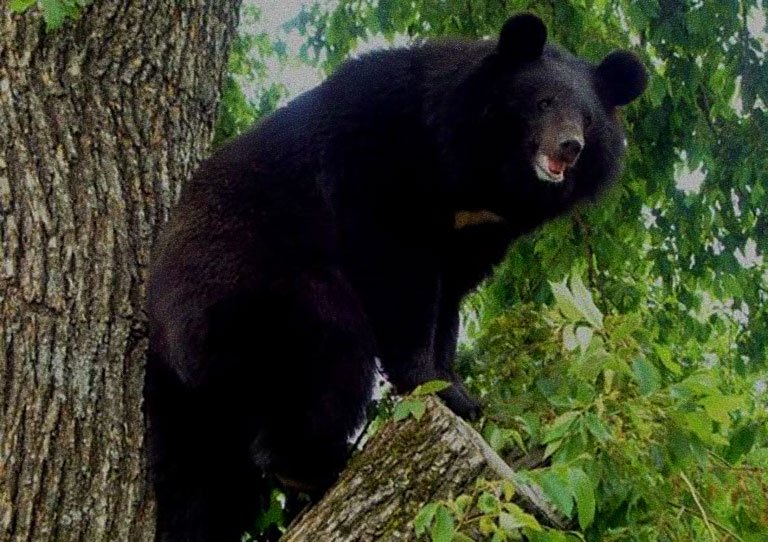

Action
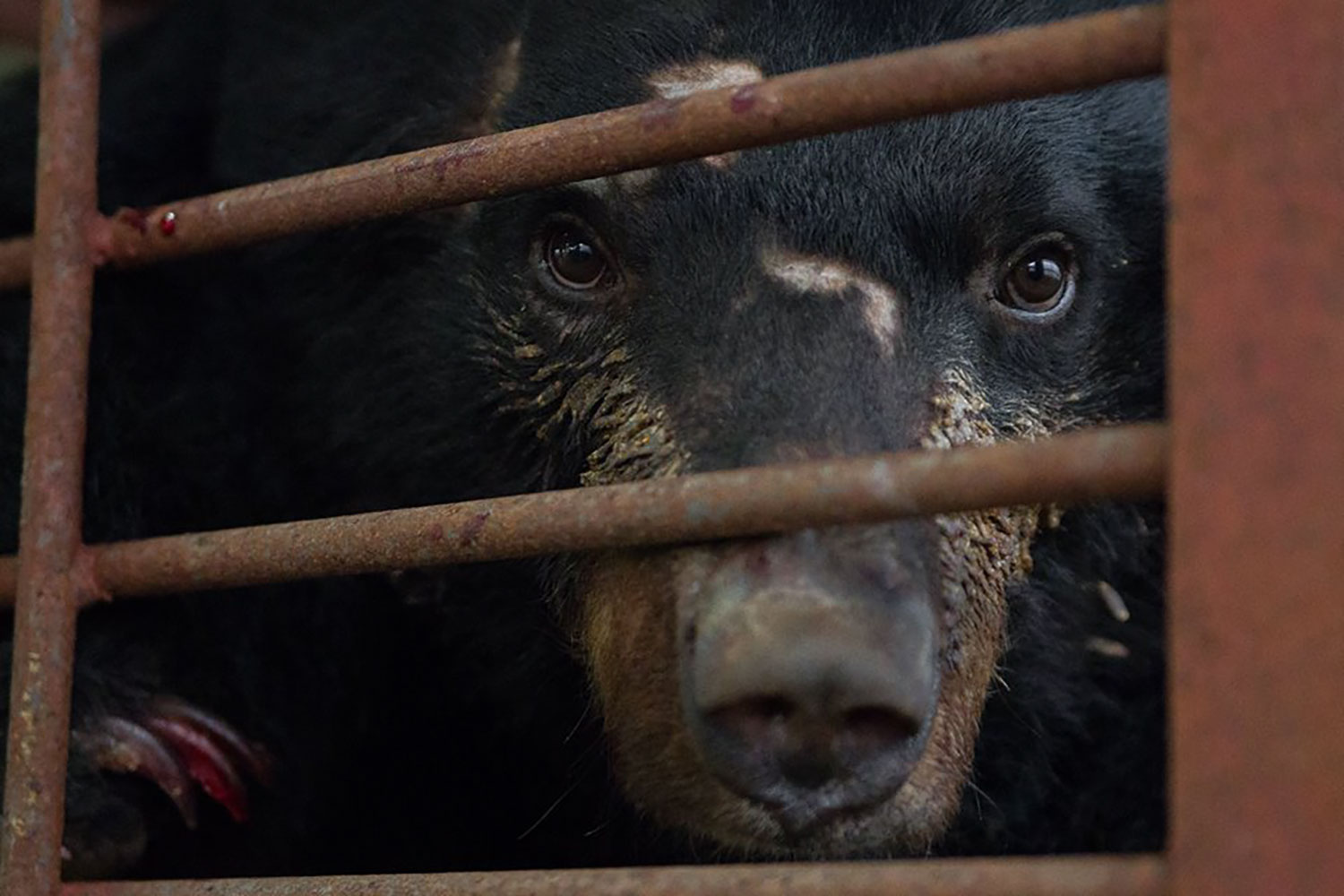
No matter where you live on the planet, you can be a part of the effort to end bile bear farming. By choosing to take a course of action on behalf of these innocent animals who cannot speak for themselves, you become an integral part of a global effort that will, hopefully, soon make the bear bile industry a thing of the past. Here are some ways you can take action:
Support Bile Bear Advocacy Organizations & Bile Bear Sanctuaries

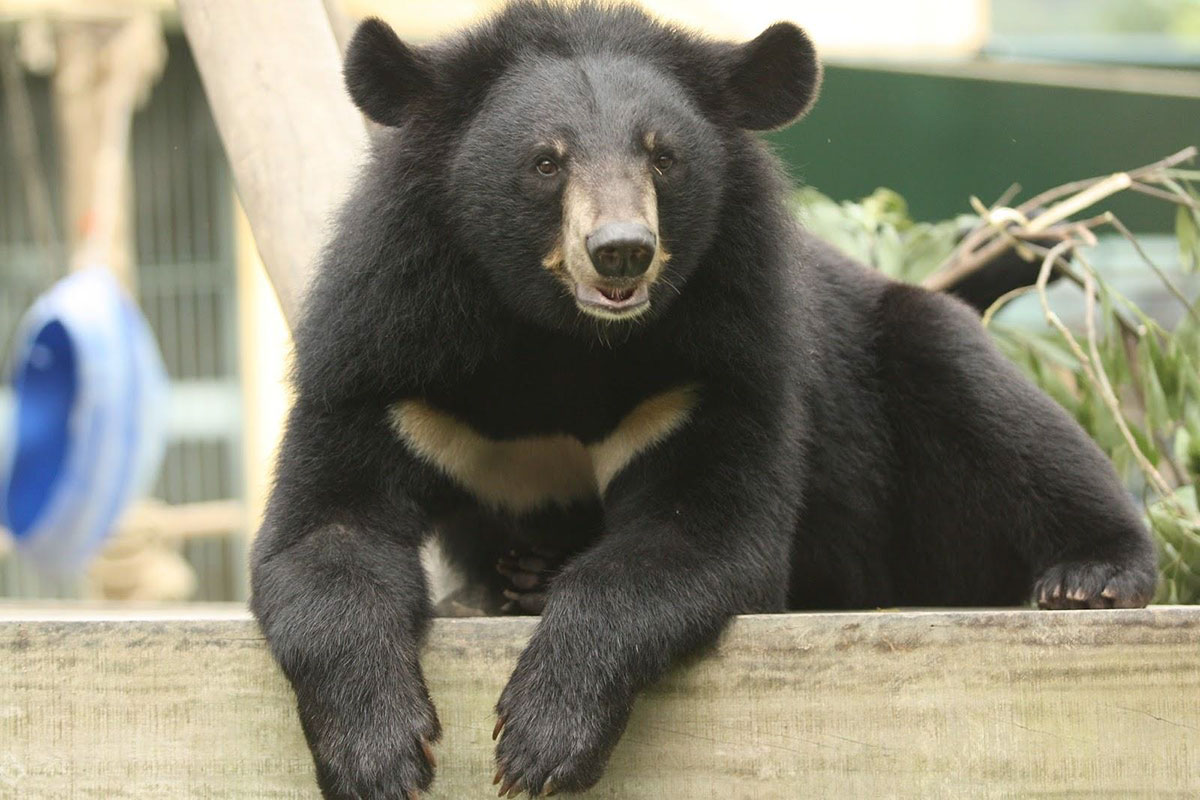
Animals Asia is one of the worlds most vocal and effective bile bear advocacy organizations, working at the national, regional and local levels for an end to the bear bile industry. They have rescued over 600 bears and run two bear sanctuaries in China and one in Vietnam. For a more detailed look at the tireless work Animals Asia does for bears, check out their webpage, which is full of information about moon bears and the movement to end bear bile farming. Animals Asia depends upon donor support for their ongoing advocacy and rescue efforts. Supporting Animals Asia financially is one of the most practical ways to help put an end to the bear bile industry.
Animals Asia support groups exist around the world, raising funds and awareness of their rescue and advocacy work. For a list of USA Animals Asia support groups, click here. If there is not one in your area, contact info@animalsasia.org and start one!

Free the Bears is very active at the grassroots level throughout Cambodia, Laos, Vietnam and Thailand, raising awareness of the bear bile industry in the local communities. To find out how to financially support Free the Bears and learn more about their ongoing bile bear rescue and advocacy work, check out their webpage.
Create your own petition at your school or place of work, collect signatures, and send or deliver to appropriate governmental official

Localized petitions—particularly those from students at a primary/secondary school or university—can have a deep impact on governmental officials. If you are a student, consider starting a petition at your school or university and getting handwritten signatures from fellow students and teachers. Make sure the petition is directed towards an official that has true influence in making legislative change concerning bear bile farming in a particular country. Below is a list of governmental officials who possess the political power to end bear bile farming in Asia. In some countries, bear bile farming is already illegal (Cambodia, Laos, Malaysia, Myanmar, Thailand and Vietnam), but the law is not enforced. These governments need to be persuaded to actively pursue and convict those individuals who are still hunting bears and operating bear bile farms illegally. These governments also need to be convinced to ban the sale of any product containing bear bile or any other part of a bear’s body.
Localized petitions—particularly those from students at a primary/secondary school or university—can have have a deep impact on governmental officials
If you are a student from a country that doesn’t engage in active bear bile farming, don’t let this dissuade you from sending a petition to one of the officials listed below. National governments are very sensitive to how their policies are viewed throughout the world. Check out Care2 Petitions for help in creating an effective petition.
- Han Changfu – People’s Republic of China, Minister of Agriculture
- Cui Tiankai – People’s Republic of China, Ambassador to the United States of America | 3505 International Place N.W., Washington D.C. 20008 | chinaembpress_us@mfa.gov.cn
- Đức Phát – Socialist Republic of Vietnam, Minister of Agriculture and Rural Development
- Nguyen Quoc Cuon – Socialist Republic of Vietnam, Ambassador to the United States of America | 1233 20th Street N.W. Suite 400, Washington, DC 20036 | vnconsular@vietnamembassy.us
- Ouk Rabun – Kingdom of Cambodia, Minister of Agriculture, Forestry and Fisheries
- Heng Hem – Kingdom of Cambodia, Ambassador to the United States of America | 4530 16th Street, N.W., Washington, DC 20011 | consular.camemb.usa@gmail.com
- Sitaheng Rasphone – Lao People’s Democratic Republic, Minister of Agriculture and Forestry
- Seng Soukhathivong – Lao People’s Democratic Republic, Ambassador to the United States of America | 2222 S St. N.W., Washington DC. 20008 | embasslao@gmail.com
- Petipong Pungbun Na Ayudhya – Kingdom of Thailand, Minister of Agriculture and Cooperatives
- Vijavat Isarabhakdi – Kingdom of Thailand, Ambassador to the United States of America | 2300 Kalorama Road N.W., Washington, D.C. 20008 | consular@thaiembdc.org
- Khin Zaw U Wunna – Republic of the Union of Myanmar (Burma), Minister of Agriculture and Irrigation
- Maung Lwin – Republic of the Union of Myanmar (Burma), Ambassador to the United States of America | 2300 S. Street N.W., Washington, D.C. 20008 | pyi.thayer@yahoo.com
Educate friends, family and your community about how bears on bear bile farms are treated, how the bear bile industry works and how it impacts your region

Throughout the United States and Canada, North American black bears are being targeted as a result of the demand for bear bile from both Asia and the Asian population in the United States and Canada. It is estimated that as many as 40,000 American black bears are illegally killed in North America each year, poached for their gallbladders and paws in the Chinese traditional medicine market. These bears are hunted in regions all over the continent. Call or write your state or provincial Department of Forestry and Department of Natural Resources and urge them to put pressure on the North American sources of bear bile in order to end the illegal killing of bears in North America. You can also contact your state/provincial and federal congressional representatives and senators, urging them to enact tougher laws and making it illegal for any American or Canadian business to sell any products containing bear bile or any other material derived from a bear. Click here to find your US state congressman and senator. Click here to find your US federal congressman and senator. Click here to find your Canadian Member of Parliament.
It is estimated that as many as 40,000 American black bears are illegally killed in North America each year, poached for their gallbladders and paws in the Chinese traditional medicine market
Post info about the bear bile industry on facebook and other social media sites

Most bile bear rescue and advocacy organizations have Facebook and Twitter accounts. Follow their pages and share photos and posts with your friends and family, keeping them up-to-date on bile bear rescues, bear sanctuary news and bile bear advocacy programs.
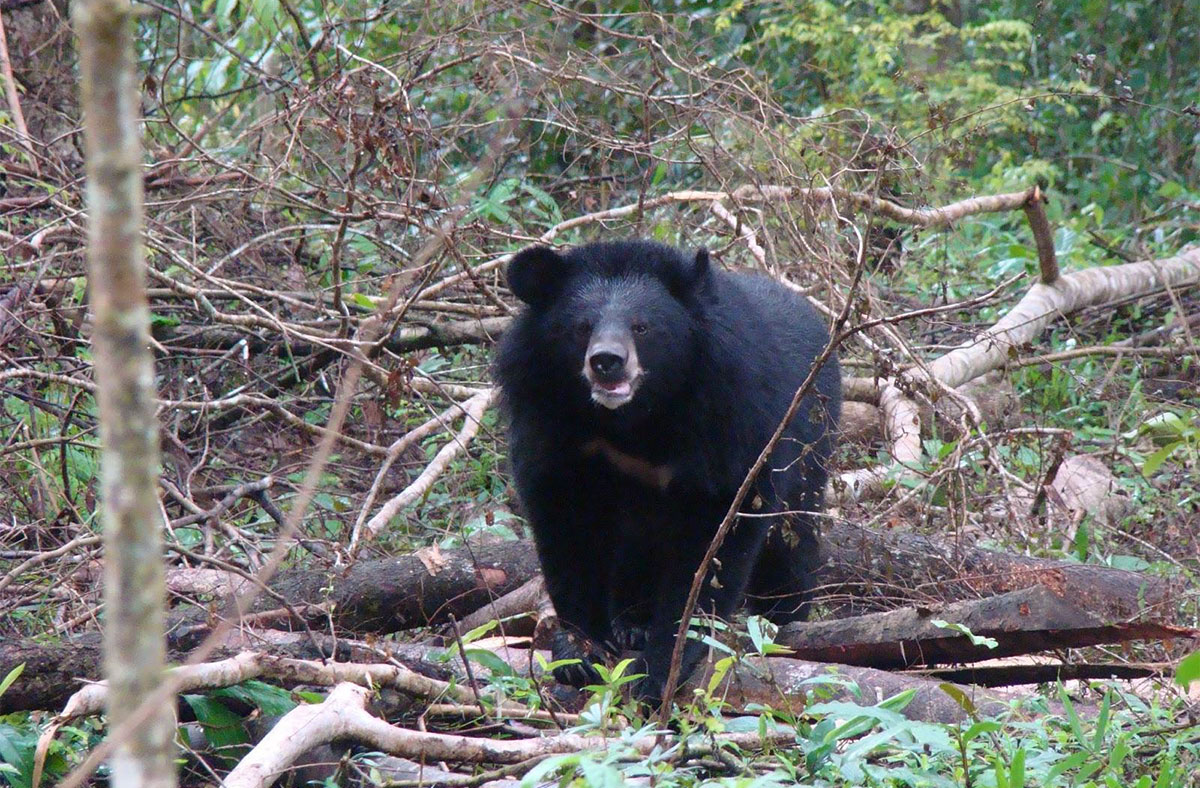

Facts
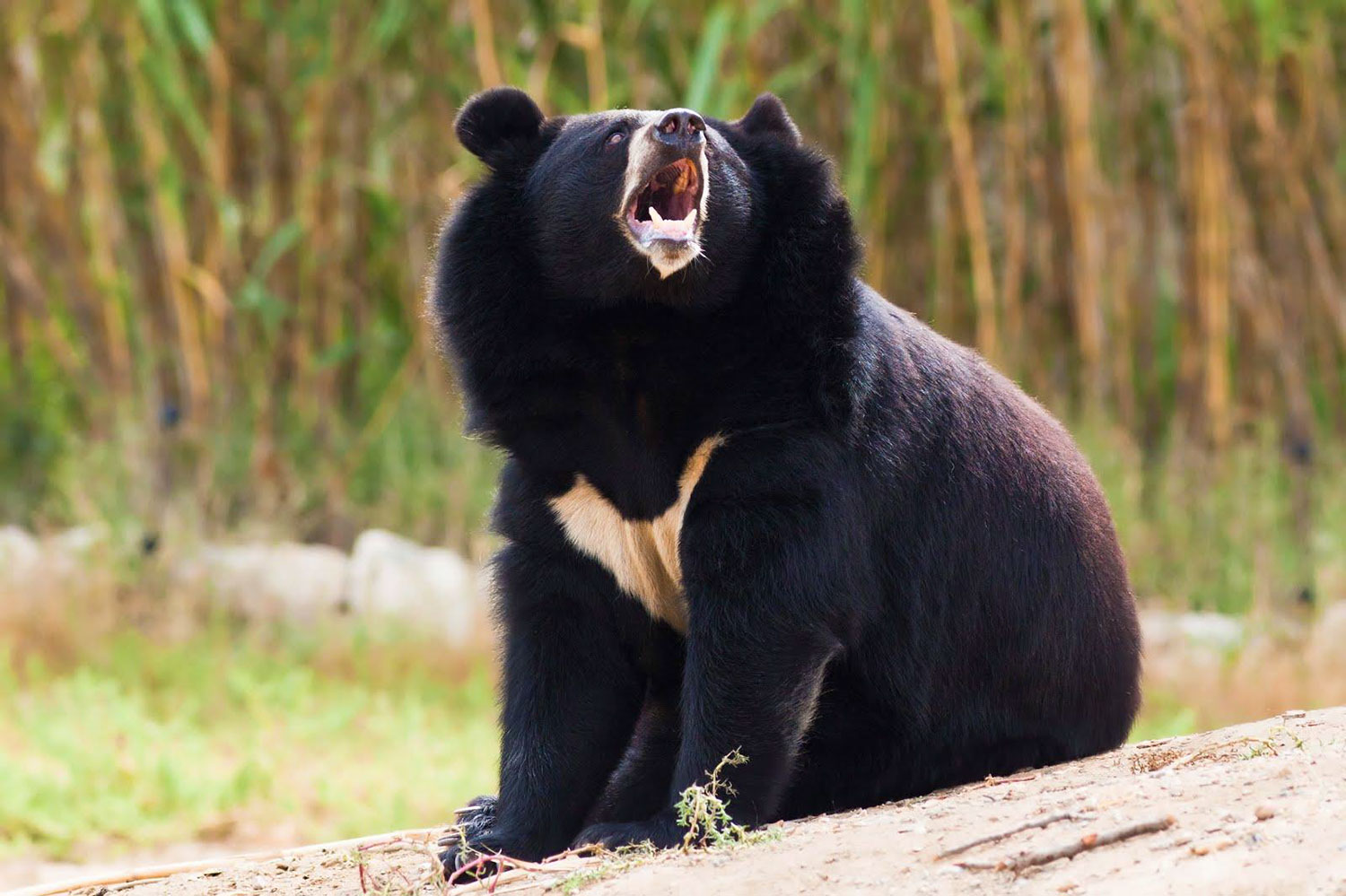
Asiatic black bears are also known as moon bears for the crescent shaped marking on their chests. They are one of eight bear species in the world, along with American black bears, brown bears, pandas, polar bears, sloth bears, spectacled bears and sun bears. Many scientists believe that Asiatic black bears are a direct surviving link of the prehistoric bears that evolved over four million years ago. The majority of bears forced into captivity for extraction of their bile are Asiatic black bears, but brown bears and sun bears are used as well.
Asiatic black bears are considered vulnerable to endangered. Their historic range once stretched more than 4,500 miles, all the way from Iran to Japan. Today, it is estimated that less than 50,000 Asiatic black bears are left in the wild. Some sources have estimated a near 50% decrease in population over the last 30 years due to hunting and poaching of the bears for their bile, and loss of natural wooded habitat to human settlement, particularly in China.
In the wild, Asiatic black bears spend half of their lives in trees – feeding, resting, sunning, and hibernating. They create “nests” high up in the trees for eating and relaxing. They have been known to create hibernation dens as high as sixty feet off the ground in hollowed out tree trunks. In contrast, on bile farms the bears are kept in “crush” or “extraction” cages, which are so small the bears can’t even turn around or stand upright. Conditions are so abnormal and stressful, witnesses have observed bears moaning in distress, banging their heads against their cages, and chewing their own paws.
The natural lifespan of an Asiatic black bear in the wild is 25-30 years. The average lifespan of an Asiatic black bear on a bile farm is five years. The quality of life and conditions on bile farms are so horrendous that the bears regularly suffer from a variety of physical and psychological ailments including hair loss, malnutrition, stunted growth, blindness, arthritis, and severe muscle mass loss. Often, the owners of bile farms have the bears’ teeth and claws removed to reduce the threat of injury.
Asiatic black bears are very intelligent and quite communicative. They possess a wide range of vocalizations, including grunts, roars, whines, slurping sounds and a threatening form of roar used when wounded or angry. They emit loud hisses when issuing warnings or threats, and scream when fighting. When approaching other bears, they produce a unique”tut tut” sound as a greeting. When courting, they emit clucking sounds.
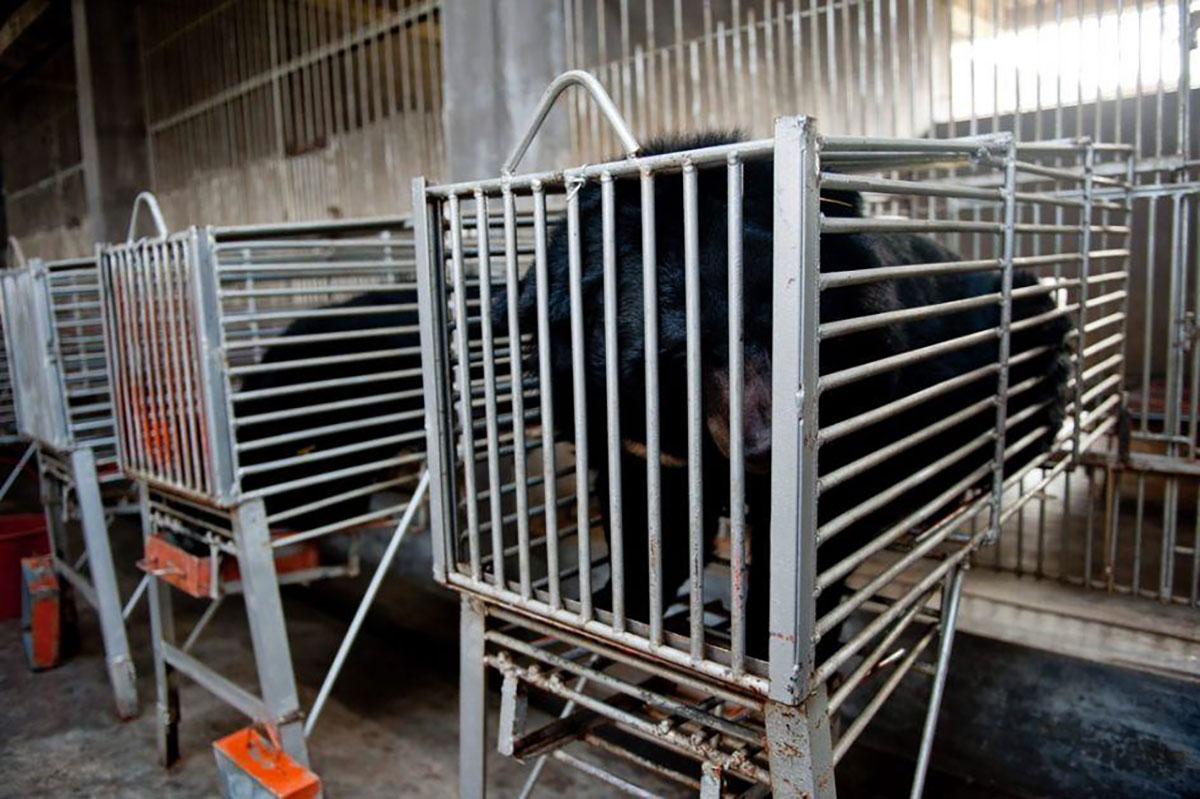

Explore
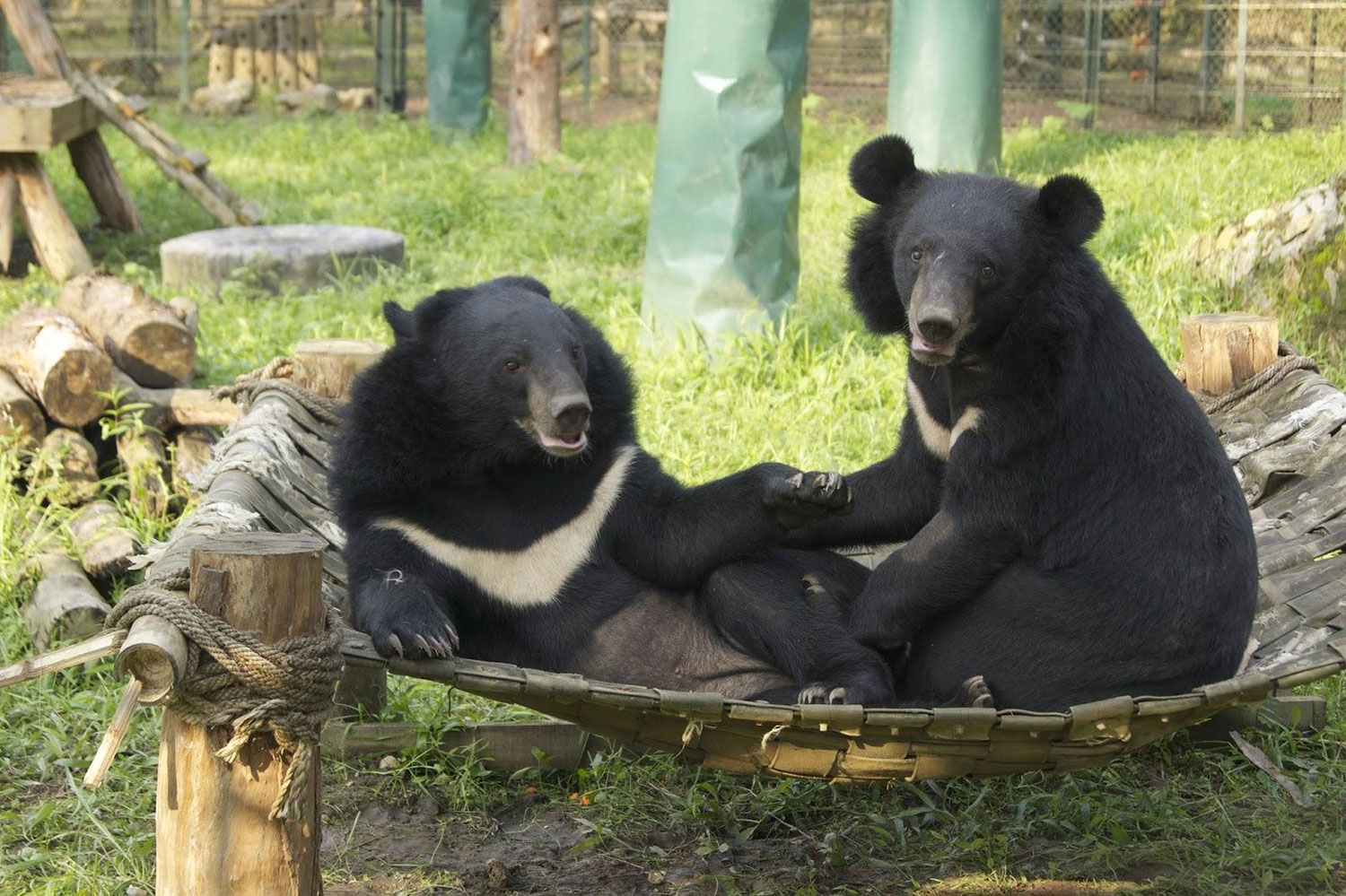
See

Explore the amazing world of Asian moon bears and learn more about their fascinating lives through these video clips and photographs.
Moon bears are very resourceful and will often make a toy out of whatever is nearby, including an old bicycle tire!
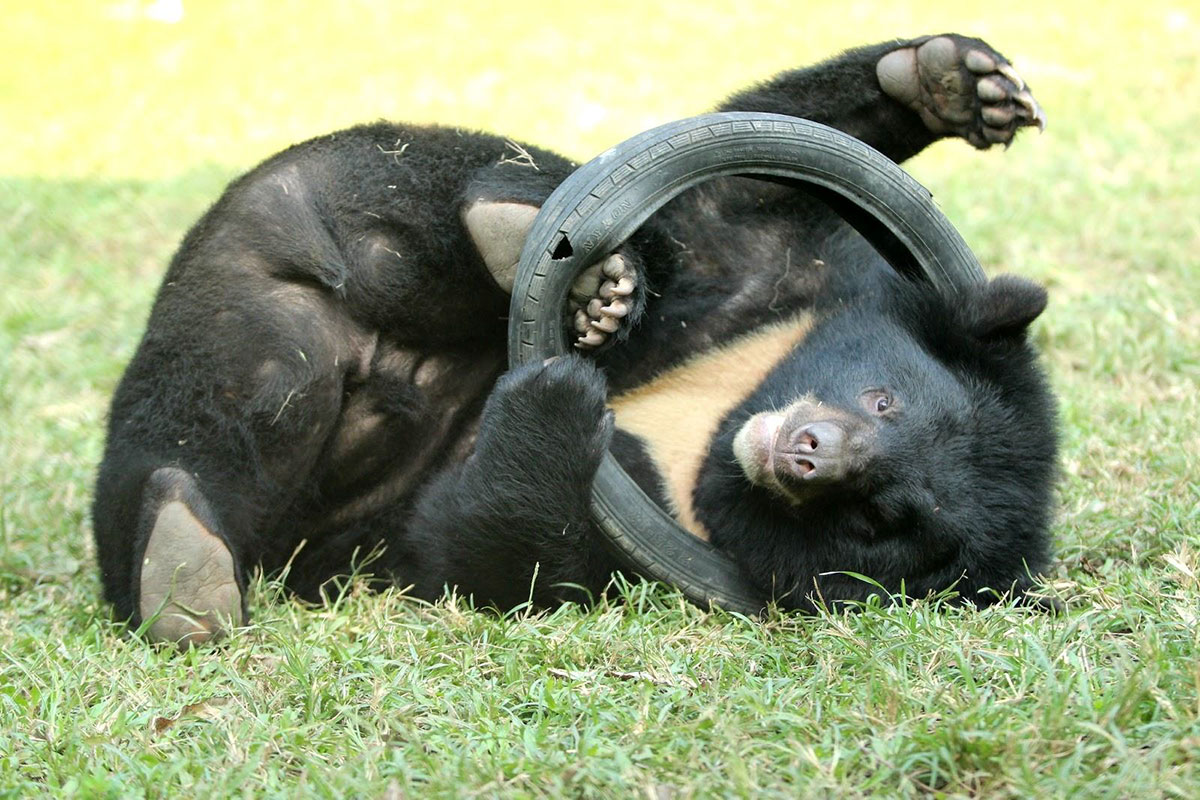
Bear friendships
Moon bears develop friendships in the same way as humans, spending time together engaging in fun activities. In this video, Billy and Bill, two rescued bears now living at the Animals Asia Chengdu Sanctuary enjoy each others company while play-wrestling in an old tractor tire.
Water Fun
Tuffy, a rescued moon bear at the Animal Asia Chengdu Sanctuary, knows how to create quite a splash. His backward flop at the end of this video is a thing of beauty.
You can visit the Animals Asia YouTube channel for more moon bear videos.
Listen

Calling for his mother
Moon bears are very verbally communicative with one another. They possess a wide range of vocalizations, including grunts, roars, whines, slurping sounds, and a threatening type of roar when wounded or angry. The North American black bear shares the same vocalization range with her cousin, the Asian moon bear. Listen to this young American black bear cub call out for his mother when he thinks she has left him behind.
Mike McIntosh of Wise About Bears has released some fantastic videos showing the advanced and expressive nature of bear communication. These videos teach the importance of allowing all bears to live peacefully in their natural habitat. He runs Bear With Us bear sanctuary and rehabilitation center in Ontario, Canada.
Interact

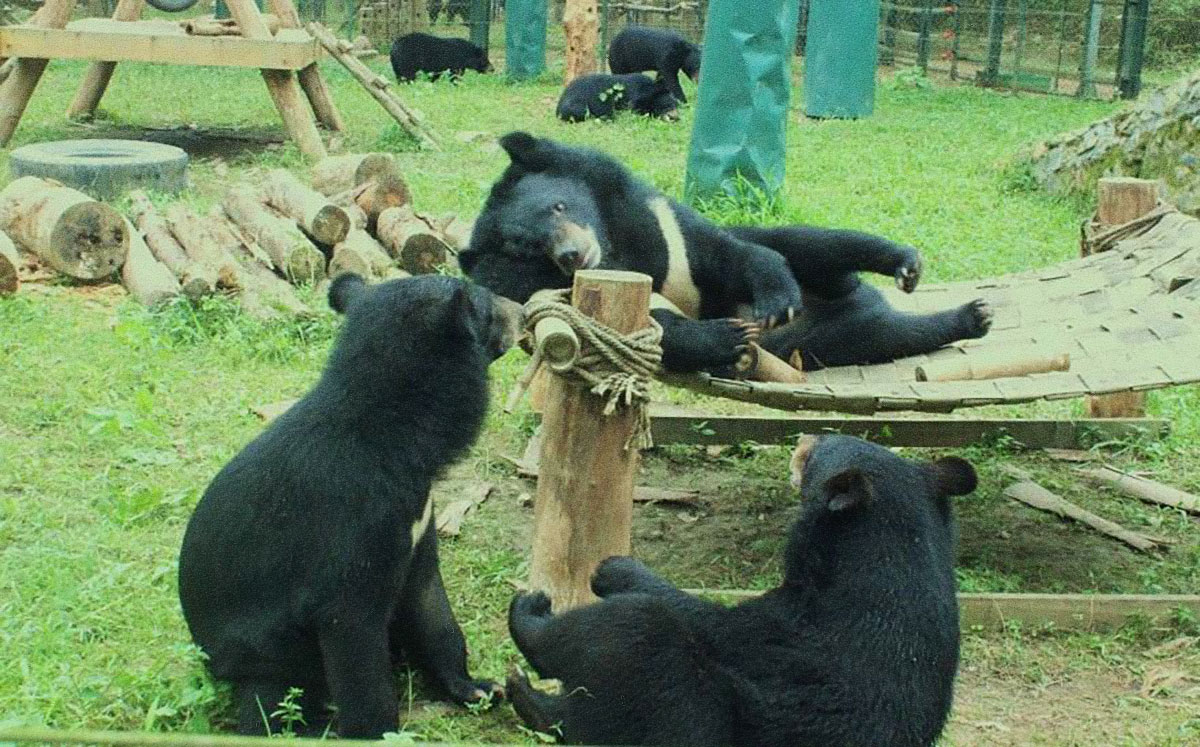
Even if you don’t live in Asia near a bear sanctuary or a bile bear advocacy organization, you can still be part of the important group of supporters and activists from all over the world who are making a difference by telling all their friends, family, and communities about what is happening in the Asian bear bile industry. The Animals Asia website has a section specifically for getting involved in ending bear bile farming wherever you may live. You can also become friends and connect with other activists from around the world through social media. Most bear bile and animal advocacy groups have accounts on Facebook and Twitter, where you will find inspiring news, posts, and a dedicated community working to make positive change. The links for the social media accounts of these groups are listed below as well as a link to their websites. Get connected!
Bile Bear Voices
Learn

The Animals Asia webpage is a treasure trove of educational information about moon bears and the movement to end bear bile farming. The site features numerous videos and photos and endless text information about the history of moon bear, the history of bear bile farming, current bear rescue/advocacy initiatives, bile bear sanctuaries, public and celebrity support, and much more. It is a great resource for any student researching the issue or anyone wanting to learn about the moon bear.
Watch

The following inspired documentaries are fantastic resources for anyone wanting to dive deeper into the issue. Some share detailed accounts of conditions on bear bile farms, others introduce the people who rescue the bears and rehabilitate them on bear sanctuaries, while others are about the efforts being taken by animal advocacy groups to end the cruel bear bile industry.
The Moon Bear
Moon Bears Journey to Freedom
Moon Bear Rescue — A decade on…
Animal Underworld


